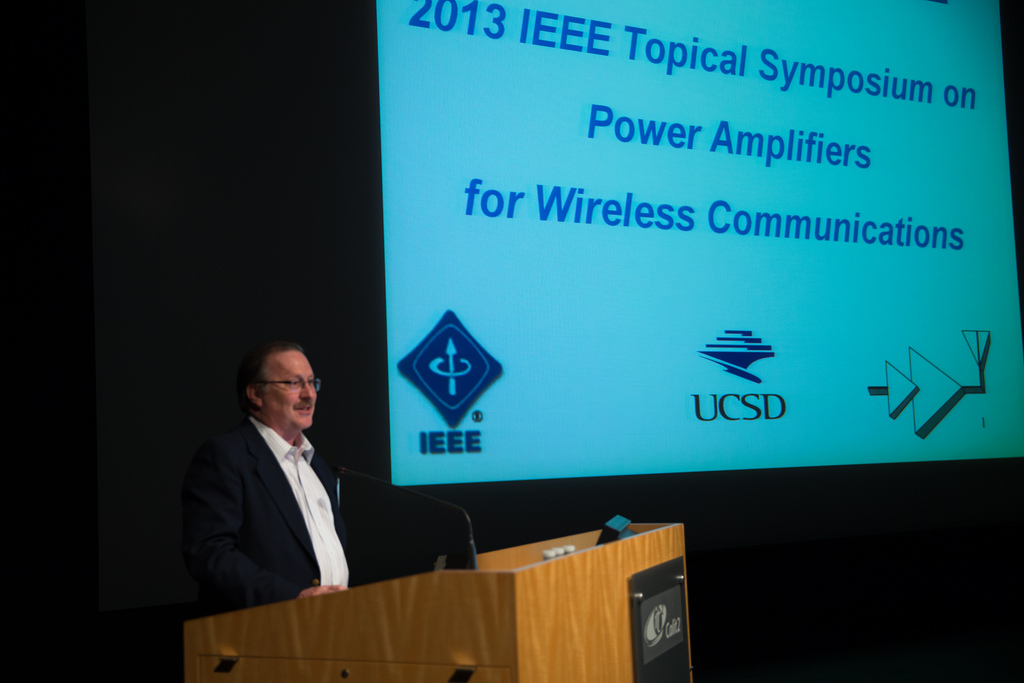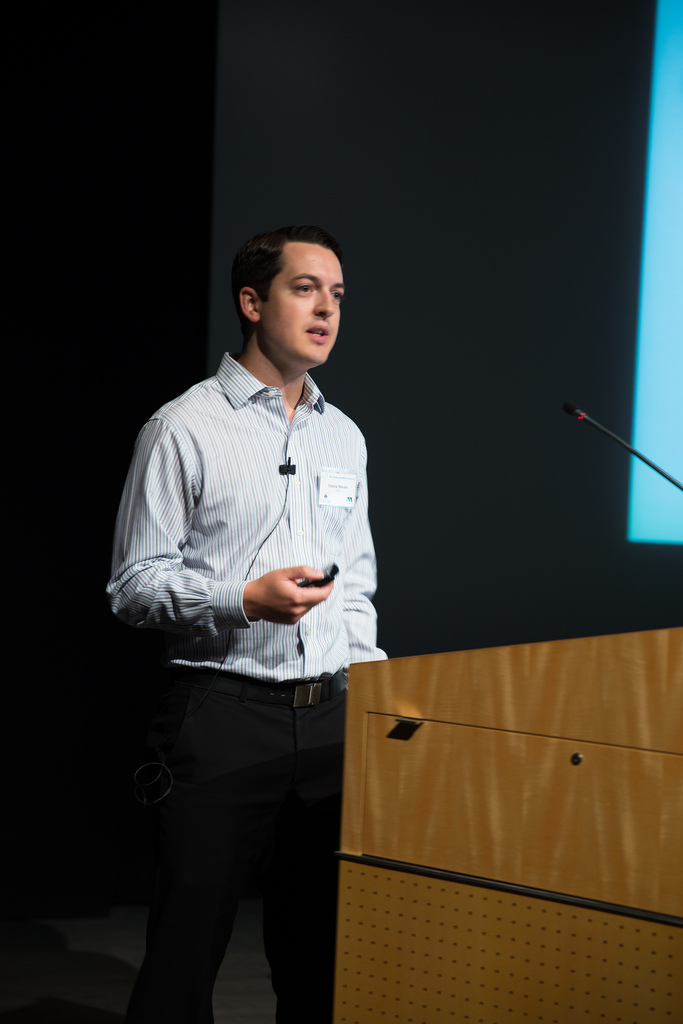Annual Symposium Brings Research One Step Closer to 'Holy Grail' of Power Amplifiers
By Tiffany Fox, (858) 246-0353, tfox@ucsd.edu
San Diego, Calif., Sept. 19, 2013 – As any broke college student can attest, recruiting friends to help with moving day requires a bit of cost-benefit analysis: You want the big guy who can move the heaviest stuff, but that same guy might cost you a fortune in beer and pizza.
|
“Power amplifiers are like that big guy,” said Electrical Engineering Ph.D. candidate Mo Mehrjoo of the University of California, San Diego Radio Frequency (RF) and Millimeter Wave Lab. “They do the heavy lifting when it comes to signal transmission, but they’re also very power-hungry. So we need to ask them to work for as short a time as possible, just to move the very ‘heavy’ stuff.”
In essence, power amplifiers aren’t much different from guitar amps. The pick-ups on a guitar transduce the acoustic sound of the guitar string and turn it into an electrical impulse, which is then amplified, whereas a power amplifier (PA) boosts a signal from cell phone so that it’s ‘loud enough’ for a base station to hear.
Given that power amplifiers are the last stage in the signal transmission chain, they are also so-called ‘energy hogs’ (they require a lot of voltage to ‘push’ the signal out). Electrical engineers and computer scientists have long tried to reduce the electricity required to transmit cellular voice signals by making power amplifiers more efficient, and many of those techniques were discussed at the 2013 IEEE Topical Symposium on Power Amplifiers for Wireless Communications, a convergence of industry and academic research presentations held last week at UC San Diego’s Qualcomm Institute.
But voice data is only half the story. Now smartphones are being used to download YouTube videos via 4G networks, to upload photos to the cloud via Wi-Fi and even to monitor users’ heart rates via Bluetooth-equipped devices. Each of those tasks occurs on a different band on the wireless spectrum, and each one of those bands requires a power amplifier that is programmed with the appropriate wireless standards.
“A few years ago there was only one power amplifier in your cell phone,” said Associate Professor of Electrical and Computer Engineering Jim Buckwalter, who directs the university’s High-speed Integrated Circuit Lab. “There are seven or eight power amplifiers in cell phones today, with more projected for the future, and right now they all speak different ‘languages.’
“All those different languages, or standards, can cause spectrum interference when you’re doing multiple operations on your phone at once,” he added. “And then there’s the question of how we can keep up with the bandwidth demands of the future, when we’ll be dealing with 1,000 times the data and 10 times the data rates that we’re experiencing today.”
Those 1000x and 10x figures were often repeated at the Symposium, which featured speakers from UC San Diego, UC Berkeley, Nanyang Technological University of Singapore and several other universities that play a major role in PA research. Industry partners Qualcomm, MaXentric Technologies, Taliesin Technology, WiSpry and several other companies also presented their research and development, much of which is focused on creating what Buckwalter calls “the holy grail” of power amplifiers: a single power device that can be reconfigured to various bands “on the fly” for multiple standards.
“There are a lot of challenges with this because power amplifiers are operating in such extreme environments (with so much interference),” Buckwalter explained. “They need to co-exist nicely, and things that are reprogrammable don’t co-exist nicely. One of the big indications that this area is hot is that Qualcomm has announced the RF360 project, their solution for a single chip for all LTE bands.” LTE stands for “Long Term Evolution” and is a standard for wireless communication of high speed data for mobile phones.
Paul Draxler, a principal engineer in Qualcomm’s Advanced Radio Technology group who helped organize the symposium, noted that this increasingly “complicated radio environment” is further exacerbated by the role that service providers play.
“Another challenge is that the phone itself will have to be able to access licensed bands (like the ones Verizon provides) and unlicensed bands, like Wi-Fi,” said Draxler. “If Starbucks wants to put up Wi-Fi hotspot, they can do that without licensing, whereas a licensed band has to make arrangements with Verizon and all the different service providers. But your phone has to be able to transparently move from those spectrum allocations to whatever has been licensed for it.”
|
Of course, most people don’t care what frequencies their phones are communicating on as long as they function properly and their battery life is good.
“But,” Draxler added, “if manufacturers want radio chips with no size limit on the phone and want them to perform perfectly, we have to get as many of the different configurations into the form factor at or below cost. It’s very hard to cram 15-18 power amplifiers onto a phone that way.”
And PA performance can have a direct impact on user experience, Draxler said. “The PA needs to get a signal to the base station, but it also needs to do so in a way where it doesn’t overheat and drop your call. When your phone has no bars and heats up, that’s the PA working overtime.”
Draxler pointed out that this heat factor has been reduced by a factor of five in recent years, partly through research into handset envelope tracking (designed to reduce hotspots in cell phones) as well as research into envelope-tracking for base stations (designed to reduce A/C or cooling load) carried out by former UC San Diego researcher Donald Kimball.
Kimball, an affiliate of the UCSD Qualcomm Institute and now the Chief Technology Officer of MaXentric, said he was excited by UC Los Angeles Associate Professor of Electrical Engineering Ethan Wang’s presentation on Digital Voltage Mode Class D Technique, or what Kimball referred to as a “digital Doherty technique.”
“The Doherty Technique separates a signal into the peak part of the signal and the amplitude part of signal to achieve high efficiency,” Kimball explained. “The reason Wang’s presentation was exciting is that it’s an all-digital technology, which means the output could come from really fast microprocessor rather than from a bunch of microwave components. That means it’s simpler and cheaper.”
Another presentation that piqued the interest of several engineers in attendance was UCSD Assistant Professor of Electrical and Computer Engineering Patrick Mercier’s talk on Body Area Networks, or BANs. BANs are essentially wearable computing devices that create a wireless networks for one person -- think Google Glass, or health-related BANs like FitBit that communicate with a smart phone.
Mercier noted that “wearable sensors or actuators are energy-scarce,” (they’re small devices that don’t have room for big batteries), “so we need to push communication complexity to the smartphone, which is energy-rich and can therefore handle the majority of the complexities of communication, enabling wearable devices that are very low-power.”
“There are a number of other trade-offs when making design decisions,” he added. “Path loss around the body is a difficult problem because the body itself actually impedes the communication link. To further compound the issue, it gets worse when you’re moving around a lot.
“But we still need to ensure the reliability and quality of service in BANs when there are a lot of people using them all in the same vicinity. Fortunately, frequencies allotted for medical BANs are essentially empty right now, which helps. Regardless, more research is necessary to achieve high efficiency at high data rates and low output power.”
In addition to the focus on multi-band radio frequency and BANs, another hot topic at the Symposium was the potential of millimeter wave plans.
“A cellular network operates at 2 GHz while millimeter wave operates above 30 GHz, which is roughly 10 times higher frequency,” Buckwalter explained. “The bandwidth is limited in RF bands, but millimeter wave has more bandwidth. With it, we can do things like beam steering and point our information directly at a base station rather than directing it everywhere, which cuts down on signal interference.”
Buckwalter noted that Samsung has announced plans for a 5G network, which is a millimeter wave plan based on a phased signal array “that point beams at people and follows them around.”
“The point is that we want to build hardware that is not bandwidth limited,” he added. “We’re trying to provide more capacity for people than we currently have, since we’re being sold on this idea there’s always going to be this receding horizon of data -- there’s always going to be more of it. Think of all the data coming from wearable medical devices alone. We’re trying to build the infrastructure for the superhighways of the future because each person out there is inevitably going to need this superhighway.”
And they’re also going to need ‘bigger, stronger guys’ to help move the data along that highway (so long as those big guys are small enough to fit on a microchip).
Media Contacts
Tiffany Fox, (858) 246-0353, tfox@ucsd.edu



